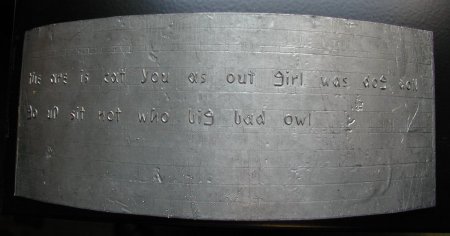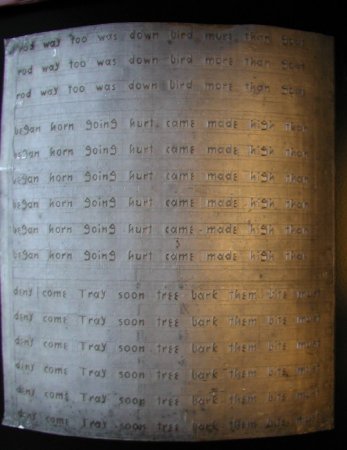Object ID:
1992.314.15a-g
Title:
Boston Line Letter embossing plates
Description:
7 plates, Boston Line Letter vocabulary words, various sizes; (a) 3.75 x 10.25", two lines of words beginning with the and ending with owl; (b) 11.75 x 10.5", fifteen lines of words, first three lines "rod" to "goat,", second six lines, "began" to "than", last six lines "deny" to "must"; (c) 11.75 x 10.5", fifteen lines of words, first three lines "keep" to "play", second six lines, "time" to "cats", last six lines "dogs" to "hook"; (d) 11.75 x 10.5", fifteen lines of words, first six lines "Jane" to "make", second six lines, "that" to "bids", last three lines "keep" to "play"; (e) 11.75 x 10.5", fifteen lines of words, first six lines "yet" to "fall", second six lines, "well" to "try", last three lines "rod" to "goat"; (fg) 7.375 x 10.25", lines of vocabulary word.
Date:
ca. 1885
Made by:
American Printing House for the Blind
Place of Origin:
Louisville, KY
Provenance:
1885 Annual Report: "The unique method of stereotyping, by which is secured a flexible stereotype plate, made of tin foil, amalgamated to a sheet of ordinary roofing tin, is the quickest, and cheapest, and for embossing work the best method in use. The double-cylinder press, made from special designs, prints four pages at every revolution, and will make thirty or more revolutions a minute. The flexible plates adapt themselves to the cylinders without any planing, and the character of the embossing speaks for itself."
Boston Line Letter was developed by Samuel Gridley Howe at the Perkins Institute in 1835. It was the dominant tactile alphabet in America for over 50 years and continued to be carried by APH into the 1920s.
Boston Line Letter was developed by Samuel Gridley Howe at the Perkins Institute in 1835. It was the dominant tactile alphabet in America for over 50 years and continued to be carried by APH into the 1920s.
Credit Line:
APH Collection, 1992.314

